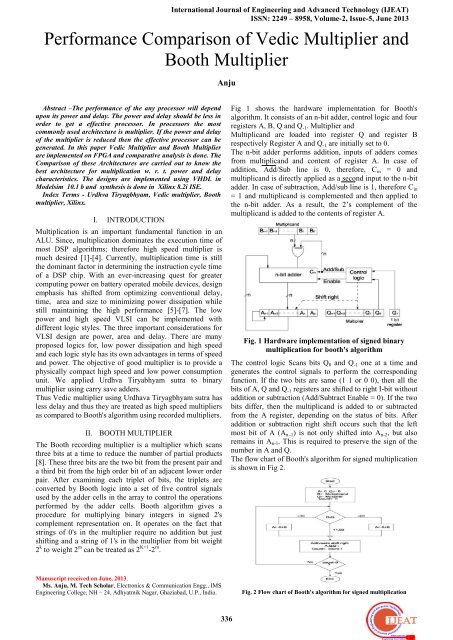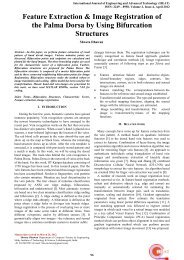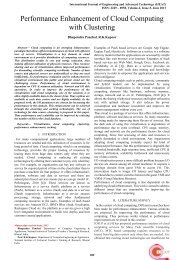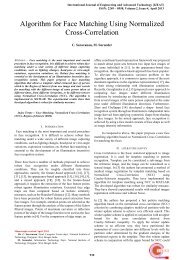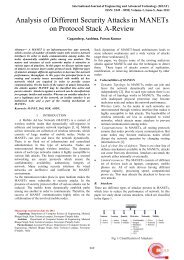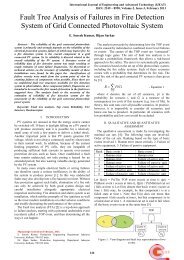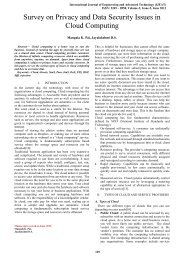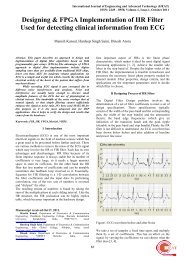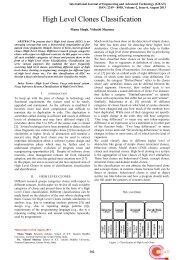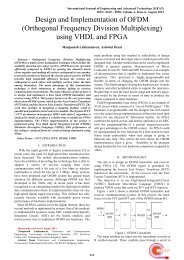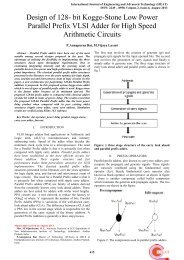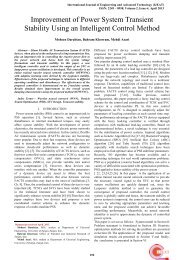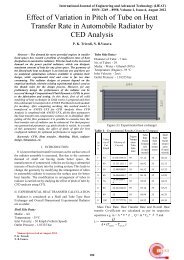Performance Comparison of Vedic Multiplier and Booth Multiplier
Performance Comparison of Vedic Multiplier and Booth Multiplier
Performance Comparison of Vedic Multiplier and Booth Multiplier
You also want an ePaper? Increase the reach of your titles
YUMPU automatically turns print PDFs into web optimized ePapers that Google loves.
International Journal <strong>of</strong> Engineering <strong>and</strong> Advanced Technology (IJEAT)<br />
ISSN: 2249 – 8958, Volume-2, Issue-5, June 2013<br />
<strong>Performance</strong> <strong>Comparison</strong> <strong>of</strong> <strong>Vedic</strong> <strong>Multiplier</strong> <strong>and</strong><br />
<strong>Booth</strong> <strong>Multiplier</strong><br />
Anju<br />
Abstract –The performance <strong>of</strong> the any processor will depend<br />
upon its power <strong>and</strong> delay. The power <strong>and</strong> delay should be less in<br />
order to get a effective processor. In processors the most<br />
commonly used architecture is multiplier. If the power <strong>and</strong> delay<br />
<strong>of</strong> the multiplier is reduced then the effective processor can be<br />
generated. In this paper <strong>Vedic</strong> <strong>Multiplier</strong> <strong>and</strong> <strong>Booth</strong> <strong>Multiplier</strong><br />
are implemented on FPGA <strong>and</strong> comparative analysis is done. The<br />
<strong>Comparison</strong> <strong>of</strong> these Architectures are carried out to know the<br />
best architecture for multiplication w. r. t. power <strong>and</strong> delay<br />
characteristics. The designs are implemented using VHDL in<br />
Modelsim 10.1 b <strong>and</strong> synthesis is done in Xilinx 8.2i ISE.<br />
Index Terms - Urdhva Tiryagbhyam, <strong>Vedic</strong> multiplier, <strong>Booth</strong><br />
multiplier, Xilinx.<br />
I. INTRODUCTION<br />
Multiplication is an important fundamental function in an<br />
ALU. Since, multiplication dominates the execution time <strong>of</strong><br />
most DSP algorithms; therefore high speed multiplier is<br />
much desired [1]-[4]. Currently, multiplication time is still<br />
the dominant factor in determining the instruction cycle time<br />
<strong>of</strong> a DSP chip. With an ever-increasing quest for greater<br />
computing power on battery operated mobile devices, design<br />
emphasis has shifted from optimizing conventional delay,<br />
time, area <strong>and</strong> size to minimizing power dissipation while<br />
still maintaining the high performance [5]-[7]. The low<br />
power <strong>and</strong> high speed VLSI can be implemented with<br />
different logic styles. The three important considerations for<br />
VLSI design are power, area <strong>and</strong> delay. There are many<br />
proposed logics for, low power dissipation <strong>and</strong> high speed<br />
<strong>and</strong> each logic style has its own advantages in terms <strong>of</strong> speed<br />
<strong>and</strong> power. The objective <strong>of</strong> good multiplier is to provide a<br />
physically compact high speed <strong>and</strong> low power consumption<br />
unit. We applied Urdhva Tiryabhyam sutra to binary<br />
multiplier using carry save adders.<br />
Thus <strong>Vedic</strong> multiplier using Urdhava Tiryagbhyam sutra has<br />
less delay <strong>and</strong> thus they are treated as high speed multipliers<br />
as compared to <strong>Booth</strong>'s algorithm using recorded multipliers.<br />
II. BOOTH MULTIPLIER<br />
The <strong>Booth</strong> recording multiplier is a multiplier which scans<br />
three bits at a time to reduce the number <strong>of</strong> partial products<br />
[8]. These three bits are the two bit from the present pair <strong>and</strong><br />
a third bit from the high order bit <strong>of</strong> an adjacent lower order<br />
pair. After examining each triplet <strong>of</strong> bits, the triplets are<br />
converted by <strong>Booth</strong> logic into a set <strong>of</strong> five control signals<br />
used by the adder cells in the array to control the operations<br />
performed by the adder cells. <strong>Booth</strong> algorithm gives a<br />
procedure for multiplying binary integers in signed 2's<br />
complement representation on. It operates on the fact that<br />
strings <strong>of</strong> 0's in the multiplier require no addition but just<br />
shifting <strong>and</strong> a string <strong>of</strong> 1's in the multiplier from bit weight<br />
2 k to weight 2 m can be treated as 2 K+1 -2 m .<br />
Fig 1 shows the hardware implementation for <strong>Booth</strong>'s<br />
algorithm. It consists <strong>of</strong> an n-bit adder, control logic <strong>and</strong> four<br />
registers A, B, Q <strong>and</strong> Q -1 . <strong>Multiplier</strong> <strong>and</strong><br />
Multiplic<strong>and</strong> are loaded into register Q <strong>and</strong> register B<br />
respectively Register A <strong>and</strong> Q -1 are initially set to 0.<br />
The n-bit adder performs addition, inputs <strong>of</strong> adders comes<br />
from multiplic<strong>and</strong> <strong>and</strong> content <strong>of</strong> register A. In case <strong>of</strong><br />
addition, Add/Sub line is 0, therefore, C in = 0 <strong>and</strong><br />
multiplic<strong>and</strong> is directly applied as a second input to the n-bit<br />
adder. In case <strong>of</strong> subtraction, Add/sub line is 1, therefore C in<br />
= 1 <strong>and</strong> multiplic<strong>and</strong> is complemented <strong>and</strong> then applied to<br />
the n-bit adder. As a result, the 2’s complement <strong>of</strong> the<br />
multiplic<strong>and</strong> is added to the contents <strong>of</strong> register A.<br />
Fig. 1 Hardware implementation <strong>of</strong> signed binary<br />
multiplication for booth's algorithm<br />
The control logic Scans bits Q 0 <strong>and</strong> Q -1 one at a time <strong>and</strong><br />
generates the control signals to perform the corresponding<br />
function. If the two bits are same (1 1 or 0 0), then all the<br />
bits <strong>of</strong> A, Q <strong>and</strong> Q -1 registers are shifted to right I-bit without<br />
addition or subtraction (Add/Subtract Enable = 0). If the two<br />
bits differ, then the multiplic<strong>and</strong> is added to or subtracted<br />
from the A register, depending on the status <strong>of</strong> bits. After<br />
addition or subtraction right shift occurs such that the left<br />
most bit <strong>of</strong> A (A n–1 ) is not only shifted into A n-2 , but also<br />
remains in A n-1 . This is required to preserve the sign <strong>of</strong> the<br />
number in A <strong>and</strong> Q.<br />
The flow chart <strong>of</strong> <strong>Booth</strong>'s algorithm for signed multiplication<br />
is shown in Fig 2.<br />
Manuscript received on June, 2013.<br />
Ms. Anju, M. Tech Scholar, Electronics & Communication Engg., IMS<br />
Engineering College, NH – 24, Adhyatmik Nagar, Ghaziabad, U.P., India.<br />
Fig. 2 Flow chart <strong>of</strong> <strong>Booth</strong>'s algorithm for signed multiplication<br />
336
<strong>Performance</strong> <strong>Comparison</strong> <strong>of</strong> <strong>Vedic</strong> <strong>Multiplier</strong> <strong>and</strong> <strong>Booth</strong> <strong>Multiplier</strong><br />
Example-1 0101(5) x 0100(4)<br />
result bit <strong>and</strong> 01 as the carry. Thus we will get the following<br />
expressions [12]-[13].<br />
R 0=A 0B 0<br />
C 1R 1=A 0B 1+A 1B 0<br />
C 2R 2=C 1+A 0B 2+A 2B 0+A 1B 1<br />
C 3R 3=C 2+A 3B 0+A 0B 3+A 1B 2+A 2B 1<br />
C 4R 4=C 3+A 4B 0+A 0B 4+A 3B 1+A 1B 3+A 2B 2<br />
C 5R 5=C 4+A 5B 0+A 0B 5+A 4B 1+A 1B 4+A 3B 2+A 2B 3<br />
C 6R 6=C 5+A 6B 0+A 0B 6+A 5B 1+A 1B 5+A 4B 2+A 2B 4 +A 3B 3<br />
C 7R 7=C 6+A 7B 0+A 0B 7+A 6B 1+A 1B 6+A 5B 2+A 2B 5+A 4B 3+A 3B 4<br />
C 8R 8=C 7+A 7B 1+A 1B 7+A 6B 2+A 2B 6+A 5B 3+A 3B 5+A 4B 4<br />
C 9R 9=C 8+A 7B 2+A 2B 7+A 6B 3+A 3B 6+A 5B 4 +A 4B 5<br />
C 10R 10=C 9+A 7B 3+A 3B 7+A 6B 4+A 4B 6+A 5B 5<br />
C 11R 11=C 10+A 7B 4+A 4B 7+A 6B 5+A 5B 6<br />
C 12R 12=C 11+A 7B 5+A 5B 7+A 6B 6<br />
C 13R 13=C 12+A 7B 6+A 6B 7<br />
C 14R 14=C 13+A 7B 7<br />
Final Product 0101 x 0100 = 00010100<br />
Here form the above example it can be proved that the<br />
addition/subtraction operation can be skipped if the<br />
successive bits in the multiplic<strong>and</strong> are same.<br />
III. URDHAVA MULTIPLIER<br />
The use <strong>of</strong> <strong>Vedic</strong> mathematics lies in the fact that it<br />
reduces the typical calculations in conventional mathematics<br />
to very simple ones. This is so because the <strong>Vedic</strong> formulae<br />
are claimed to be based on the natural principles on which<br />
the human mind works [9]-[10]. <strong>Vedic</strong> Mathematics is a<br />
methodology <strong>of</strong> arithmetic rules that allow more efficient<br />
speed implementation [11]-[12].<br />
UrdhvaTiryakbhyam Sutra is a general multiplication<br />
formula applicable to all cases <strong>of</strong> multiplication. It means<br />
“Vertically <strong>and</strong> Crosswise” [13]-[16]. The digits on the two<br />
ends <strong>of</strong> the line are multiplied <strong>and</strong> the result is added with<br />
the previous carry. When there are more lines in one step, all<br />
the results are added to the previous carry. The least<br />
significant digit <strong>of</strong> the number thus obtained acts as one <strong>of</strong><br />
the result digits <strong>and</strong> the rest act as the carry for the next step.<br />
Initially the carry is taken to be as zero. The line diagram for<br />
multiplication <strong>of</strong> two 4-bit numbers is as shown in Fig 3.<br />
C 14 R 14 R 13 R 12 R 11 R 10 R 9 R 8 R 7 R 6 R 5 R 4 R 3 R 2 R 1 R 0 being the final<br />
product [14]. Hence this is the general mathematical formula<br />
applicable to all cases <strong>of</strong> multiplication.<br />
IV. FPGA IMPLEMENTATION AND EXPERIMENTAL<br />
RESULTS<br />
In this work, 8x8 bit <strong>Vedic</strong> multiplier <strong>and</strong> 8x8 bit <strong>Booth</strong><br />
multiplier are designed in VHDL (very High speed<br />
Integrated Circuits Hardware Description Language).<br />
Logic simulation was done in Modelsim 10.1 b. Table 1<br />
& 2 <strong>and</strong> Figs 4(a) & 5(b), show the synthesis <strong>and</strong> simulation<br />
results <strong>of</strong> 8x8 bit <strong>Booth</strong> multiplier <strong>and</strong> 8x8 bit <strong>Vedic</strong><br />
multiplier respectively.<br />
When multiplic<strong>and</strong>, booth multiplier_8 bit/mplic<strong>and</strong>_in =<br />
11111111(225decimal) <strong>and</strong> multiplier, booth_multiplier_8<br />
bit/mplier_in=11111111 (225 decimal), we get the result 16-<br />
bit output booth multiplier_8 bit/product = 111111100<br />
000001 (65025.)<br />
For 8x8 bit <strong>Vedic</strong> multiplier when input multiplic<strong>and</strong> =<br />
10111111(191 decimal) <strong>and</strong> multiplier = 11111111 (225<br />
decimal). Product <strong>of</strong> 1011111 (191) x 11111111 (255)<br />
=1011111001000001 (48705)<br />
TABLE 1: Synthesis Result <strong>of</strong> 8x8 bit <strong>Vedic</strong> multiplier<br />
Device utilization Summary (estimated values)<br />
Logic utilization used Available Utilization<br />
Number <strong>of</strong> Slices 174 192 90%<br />
Number <strong>of</strong> slice Flip Flop 133 384 34%<br />
Fig. 3 Line diagram for multiplication <strong>of</strong> two 4-Bit<br />
Number<br />
Now we will extend this Sutra to binary number system.<br />
For the multiplication algorithm, let us consider the<br />
multiplication <strong>of</strong> two 8 bit binary numbers<br />
A 7 A 6 A 5 A 4 A 3 A 2 A 1 A 0 <strong>and</strong> B 7 B 6 B 5 B 4 B 3 B 2 B 1 B 0 . As the result<br />
<strong>of</strong> this multiplication would be more than 8 bits, we<br />
express it as …R 7 R 6 R 5 R 4 R 3 R 2 R 1 R 0 . As in the last case, the<br />
digits on the both sides <strong>of</strong> the line are multiplied <strong>and</strong> added<br />
with the carry from the previous step. This generates one <strong>of</strong><br />
the bits <strong>of</strong> the result <strong>and</strong> a carry. This carry is added in the<br />
next step <strong>and</strong> hence the process goes on. If more than one<br />
lines are there in one step, all the results are added to the<br />
previous carry. In each step, least significant bit acts as the<br />
result bit <strong>and</strong> all the other bits act as carry. For example, if in<br />
some intermediate step, we will get 011, then I will act as<br />
Number <strong>of</strong> 4 input LUTs ; 326 384 84%<br />
Number <strong>of</strong> Bounded 10 Bs; 67 90 74%<br />
Number <strong>of</strong> GCLKs 1 4 25%<br />
(a)<br />
TABLE 2: Synthesis Result <strong>of</strong> 8x8 bit <strong>Booth</strong> multiplier<br />
Device utilization Summary (estimated values)<br />
Logic utilization used Available Utilization<br />
Number <strong>of</strong> Slices 49 192 25%<br />
Number <strong>of</strong> slice Flip Flop 48 384 12%<br />
Number <strong>of</strong> 4 input LUTs ; 84 384 21%<br />
Number <strong>of</strong> Bounded 10 Bs; 34 90 37%<br />
Number <strong>of</strong> GCLKs 1 4 25%<br />
(b)<br />
337
International Journal <strong>of</strong> Engineering <strong>and</strong> Advanced Technology (IJEAT)<br />
ISSN: 2249 – 8958, Volume-2, Issue-5, June 2013<br />
12<br />
10<br />
8<br />
6<br />
4<br />
2<br />
0<br />
1 2<br />
<strong>Booth</strong><br />
<strong>Multiplier</strong><br />
Urdhava<br />
Multipier<br />
(a)<br />
Fig. 5b Delay <strong>Comparison</strong> for (8x8)<br />
(b)<br />
Fig. 4 Simulation results <strong>of</strong> 8x8 bit <strong>Vedic</strong> <strong>and</strong> <strong>Booth</strong><br />
<strong>Multiplier</strong><br />
140<br />
120<br />
100<br />
80<br />
60<br />
40<br />
20<br />
0<br />
1 2<br />
<strong>Booth</strong><br />
<strong>Multiplier</strong><br />
Urdhava<br />
<strong>Multiplier</strong><br />
Fig. 5c Speed <strong>Comparison</strong> for (8x8)<br />
V. EXPERIMENTAL RESULT<br />
Table 3 compares the result <strong>of</strong> Area, Delay speed <strong>and</strong> power<br />
<strong>of</strong> <strong>Booth</strong> <strong>and</strong> Urdhava Tiryakbhyam multiplier. The result<br />
shows that Urdhava Tiryakbhyam multiplier is the best<br />
multiplier compare to <strong>Booth</strong> multiplier in terms <strong>of</strong> Area,<br />
delay <strong>and</strong> power consumptions (Fig. 5)<br />
TABLE 3: Result for 8x8 <strong>Multiplier</strong><br />
12<br />
10<br />
8<br />
6<br />
4<br />
2<br />
0<br />
1 2<br />
FPGA<br />
Device<br />
Package<br />
XC2550<br />
TQ144<br />
<strong>Booth</strong><br />
<strong>Multiplier</strong><br />
Urdhava<br />
<strong>Multiplier</strong><br />
96<br />
94<br />
92<br />
90<br />
88<br />
86<br />
84<br />
82<br />
Area in<br />
LUT's<br />
Delay<br />
(ns)<br />
Speed<br />
(MH z)<br />
Memory<br />
(Kb)<br />
Power<br />
(mW)<br />
9 11.176 89.477 156440 11.30<br />
86 8.460 118.203 166744 9.29<br />
1 2<br />
<strong>Booth</strong><br />
<strong>Multiplier</strong><br />
Urdhava<br />
<strong>Multiplier</strong><br />
Fig. 5a : Area <strong>Comparison</strong> for (8x8)<br />
<strong>Booth</strong><br />
<strong>Multiplier</strong><br />
Urdhava<br />
<strong>Multiplier</strong><br />
Fig. 5d Power <strong>Comparison</strong> for (8x8)<br />
VI. CONCLUSION<br />
It can be concluded that Urdhava <strong>Multiplier</strong> is superior in<br />
all respect like speed, delay, area, complexity <strong>and</strong> power<br />
consumption. Hence Urdhava Tiryakbham is a better<br />
multiplier compared to <strong>Booth</strong> <strong>Multiplier</strong>. The power <strong>of</strong><br />
<strong>Vedic</strong> Mathematics can be explored to implement high<br />
performance multiplier in different VLSI application.<br />
REFERENCES<br />
1. Ravindra P Rajput, M. N Shanmukha Swamy, ''High Seed Modified<br />
<strong>Booth</strong> Encoder multiplier for signed <strong>and</strong> unsigned numbers'', 14 th<br />
Internaitonal Conference on Modeling <strong>and</strong> simulation, 2012 IEEE,<br />
pp. 649-654.<br />
2. Rashmi K. Lamte <strong>and</strong> Pr<strong>of</strong>. Bhasker, "Speedy Convolution using<br />
<strong>Vedic</strong> Mathematics", International Journal <strong>of</strong> Recent Trends in<br />
Engineering <strong>and</strong> Technology, Vol-05, No-01, March 2011.<br />
3. Jagadeshwar Rao M, Sanjay Dubey, "A high speed <strong>and</strong> Area<br />
Efficient <strong>Booth</strong> Recoded Wallace tree <strong>Multiplier</strong> for fast Arithmetic<br />
Circuits," Asia Pacific Conference on postgraduate Research in<br />
Microelectronics & Electronics (PPIM EASIA) 2012.<br />
4. Ch. Harish Kumar "Implementation <strong>and</strong> Analysis <strong>of</strong> Power, Area <strong>and</strong><br />
Delay <strong>of</strong> Array Urdhava, Nikhilam <strong>Vedic</strong> <strong>Multiplier</strong>s, " Internatinal<br />
Journal <strong>of</strong> Scientific <strong>and</strong> Research Publications, Volume 3, Issue 1<br />
January 2013, ISSN 2250 – 3153.<br />
338
<strong>Performance</strong> <strong>Comparison</strong> <strong>of</strong> <strong>Vedic</strong> <strong>Multiplier</strong> <strong>and</strong> <strong>Booth</strong> <strong>Multiplier</strong><br />
5. Nidhi Mittal, Abhijeet Kumar, "Hardware Implementation <strong>of</strong> FFT<br />
using vertically <strong>and</strong> crosswise Algorithm", International Journal <strong>of</strong><br />
Computer Application (0975-8887), Volume-35- No-1, December<br />
2011.<br />
6. L. Sriraman, T.N. Prabakar.'' Design <strong>and</strong> Implementation <strong>of</strong> two<br />
variable <strong>Multiplier</strong> using KCM <strong>and</strong> <strong>Vedic</strong> Mathematics, 1 st<br />
International Conference on Recent Advances in Information<br />
Technology 2012 IEEE.<br />
7. H. Thapliyal, M. B. Srinivas <strong>and</strong> H. R. Arabnia , "Design And<br />
Analysis <strong>of</strong> a VLSI Based High <strong>Performance</strong> Low Power Parallel<br />
square Architecture", in Proc. Int. Conf. Also. Math. Compo. Sc.,<br />
Las Vegas, June 2005, pp. 72-76.<br />
8. Vinoth, C. Bhaaskaran, V.S.K. Brindha, B. Sakthikumarna, S.<br />
Kavinilavu, V. Bhaskar, B. Kanagaasabapathy, M. <strong>and</strong> Sharath, B.<br />
"A novel low power <strong>and</strong> high speed Wallace tree multiplier for RISC<br />
Processer,'' 3 rd International Conference on Electronics Computer<br />
Technology (ICECT), 2011, Vol-1,April 2010,pp. 8-10 .<br />
9. Chen Ping-hua <strong>and</strong> Zhao Juan, "High-Speed Parallel 32x32-bit<br />
<strong>Multiplier</strong> Using a Radix-16 <strong>Booth</strong> Encoder", Third International<br />
Symposium on intelligent Information Technology Application<br />
Wrokshops, 2009. IITAW 09, pp.406-409, 21-22 Nov. 2009.<br />
10. Swami Bharati Krshna Tirthaji, <strong>Vedic</strong> Mathematics. Delhi: Motilal<br />
Banarsidass Publishers, 1965.<br />
11. Asmita Haveliya "A Novel Design for High Speed <strong>Multiplier</strong> .for<br />
Digital Signal Processing Applications (Ancient Indian <strong>Vedic</strong><br />
mathematics approach)" International Journal <strong>of</strong> Technology And<br />
Engineering System(IJTES):Jan - March 2011- Vo12 .No. l.<br />
12. Harpreet Singh Dhillon <strong>and</strong> Abhijit Mitra "A Digital <strong>Multiplier</strong><br />
Architecture using Urdhava Tiryakbhyam Sutra <strong>of</strong> <strong>Vedic</strong><br />
Mathematics" IEEE Conference Proceedings,2008.<br />
13. Parth Mehta, Dhanashri Gawali "Conventional versus <strong>Vedic</strong><br />
mathematical method for Hardware implementation <strong>of</strong> a multiplier"<br />
2009 International Conference on Advances in Computing, Control,<br />
<strong>and</strong> Telecommunication Technologies.<br />
14. Himanshu Thapliyal, S. Kotiyal <strong>and</strong> M.B. Srinivas, "Design <strong>and</strong><br />
Analysis <strong>of</strong> a Novel Parallel Square <strong>and</strong> Cube Architecture Based on<br />
Ancient Indian <strong>Vedic</strong> Mathematics", Proceedings on 48th IEEE<br />
International Midwest Symp-osium on Circuits <strong>and</strong> Systems<br />
(MWSCAS 2005)<br />
15. Shamim Akhtar, "VHDL Implementation <strong>of</strong> Fast NxN multiplier<br />
Base on <strong>Vedic</strong> Mathematics," Jaypee Institute <strong>of</strong> Information<br />
Technology University, Noida, 2011307 U.P, India, 2007 IEEE.<br />
16. Pushpalata Verma, K.K. Mehta, ''Implementation <strong>of</strong> an efficient<br />
multiplier based on <strong>Vedic</strong> Mathematics using EDA Tool'',<br />
International Journal <strong>of</strong> Engineering <strong>and</strong> Advance Technology<br />
(IJEAT) ISSN : 2249-8958, volume-1, Issue -5, June 2012.<br />
Ms. Anju is M. Tech student at IMS Engineering<br />
College, Ghaziabad, affiliated to Mahamaya Technical<br />
University. She is also associated to Shri Ram Swaroop<br />
Memorial Engineering College, Lucknow<br />
339


